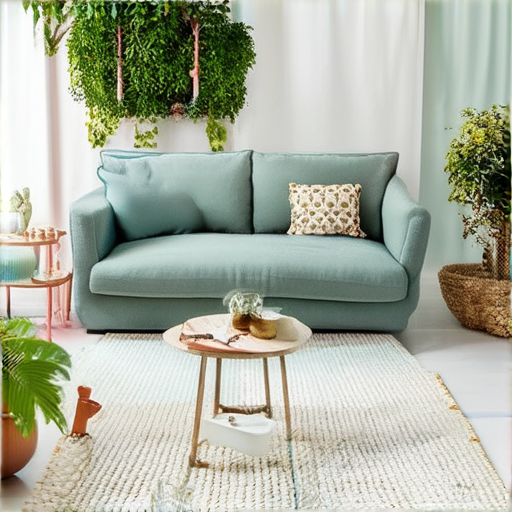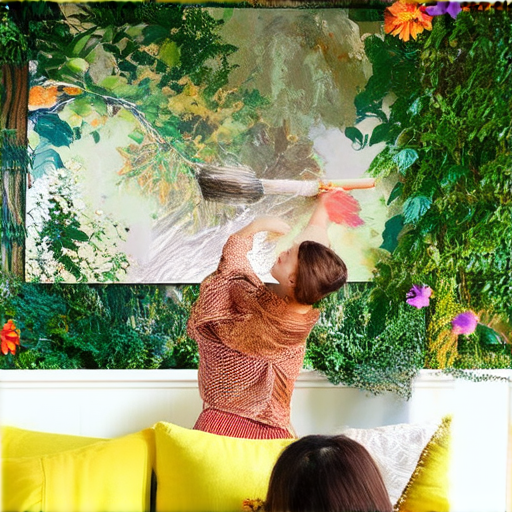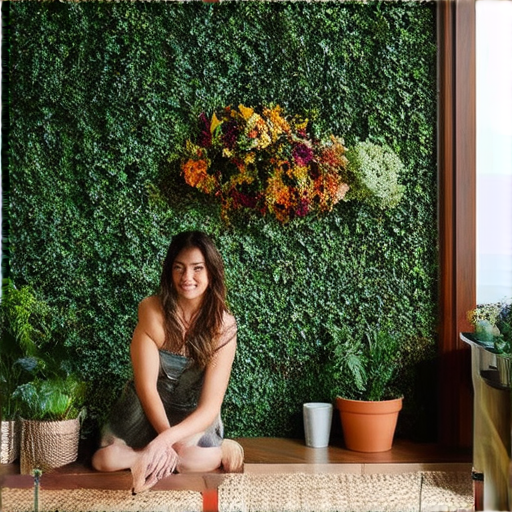As we continue to navigate the complexities of modern life, our homes have become more than just physical spaces – they’re reflections of our values and commitment to sustainability. With the growing awareness of environmental concerns, many of us are seeking ways to transform our living spaces into eco-friendly havens that not only minimize our ecological footprint but also promote well-being and creativity. In this pursuit, eco-friendly decorating has emerged as a vital aspect of creating a harmonious balance between aesthetics and sustainability.

Creating Eco-Friendly Decorations
I’m excited to share my favorite ways to make eco-friendly decorations that are not only beautiful but also sustainable.
-
Repurpose and Upcycle Old Items
You can turn old items into unique decorative pieces. For example, you can use old jars to create a beautiful centerpiece or turn an old t-shirt into a reusable bag.
- Get creative with materials you already have at home.
- Think outside the box and come up with innovative ways to reuse and recycle.
-
Use Natural Materials
Natural materials like pinecones, leaves, and branches can add a touch of elegance to your decor. You can use them to create wreaths, garlands, or centerpieces.
- Pinecones can be used to create a beautiful winter wonderland-themed decoration.
- Leaves can be used to create a stunning fall-themed decoration.
-
Make Your Own Candles
Making your own candles is a fun and easy way to create eco-friendly decorations. You can use beeswax or soy wax to create candles that are not only sustainable but also fragrant.
- Beeswax candles are a great alternative to traditional paraffin wax candles.
- Soy wax candles are biodegradable and non-toxic.
-
Use Recycled Glass
Recycled glass can be used to create beautiful vases, candle holders, or decorative bowls. You can find recycled glass at most hardware stores or online.
- Recycled glass is a great way to reduce waste and create unique decorative pieces.
- You can also use recycled glass to create beautiful mosaics.
By incorporating these eco-friendly decoration ideas into your home, you’ll not only be reducing your environmental impact but also adding a personal touch to your space.
Additional Tips:
- Always choose materials that are locally sourced and sustainable.
- Consider the longevity of the material before making a purchase.
- Get creative and experiment with different materials and techniques.
Disadvantages of Eco-Friendly Paint
Eco-friendly paint may have several drawbacks that could affect its overall performance.
- Less Durable: Eco-friendly paint may not be as long-lasting as traditional paint, requiring more frequent touch-ups and potentially leading to increased maintenance costs.
- More Coats Required: To achieve full coverage, eco-friendly paint may require additional coats, which can increase the overall cost and time required for the painting process.
- Limited Color Options: Some eco-friendly paint options may have limited color choices, making it difficult for homeowners to find a shade that suits their preferences.
- Higher Cost: While eco-friendly paint may offer environmental benefits, it can be more expensive than traditional paint, making it less accessible to budget-conscious homeowners.
- Potential Health Risks: Some eco-friendly paint ingredients may pose health risks, particularly for individuals with allergies or sensitivities, highlighting the importance of proper ventilation and safety precautions during application.
- Lower Adhesion: Eco-friendly paint may have lower adhesion properties, which can lead to peeling or flaking over time, compromising the paint’s durability and appearance.
- Specialized Application Requirements: Certain eco-friendly paint products may require specialized application techniques or equipment, adding complexity to the painting process and potentially increasing labor costs.
When considering eco-friendly paint, it’s essential to weigh these potential drawbacks against the benefits of using environmentally friendly products.
Homeowners can explore alternative solutions, such as using high-quality, eco-friendly paint products or consulting with a professional painter who has experience working with these materials.
By understanding the advantages and disadvantages of eco-friendly paint, homeowners can make informed decisions that balance their environmental concerns with their needs and budget.

Creating an Eco-Friendly Interior Space
I’m passionate about helping homeowners and DIY enthusiasts transform their living spaces into beautiful, functional, and environmentally friendly havens.
- Sustainable Materials: Choose materials that are renewable, recyclable, and non-toxic, such as bamboo, cork, and reclaimed wood.
- Energy Efficiency: Optimize natural light and ventilation, and consider installing energy-efficient lighting and appliances.
- Water Conservation: Install low-flow fixtures and greywater systems to reduce water waste.
- Waste Reduction: Implement a recycling program and encourage responsible waste disposal practices.
- Indoor Air Quality: Use air-purifying plants, HEPA filters, and non-toxic paints to promote healthy indoor air.
Eco-Friendly Interior Design Trends
Some popular eco-friendly interior design trends include:
- Biophilic Design: Incorporate natural elements, such as plants and stone, to bring the outdoors in.
- Minimalism: Emphasize simplicity and functionality to reduce waste and excess.
- Sustainable Textiles: Choose fabrics made from recycled or organic materials, such as hemp and bamboo.
- Upcycled Decor: Repurpose and reuse old items to create unique and eco-friendly decorative pieces.
Practical Tips for Creating an Eco-Friendly Interior Space
To get started on your eco-friendly interior design journey, try these simple and effective tips:
- Assess Your Space: Evaluate your current space and identify areas for improvement.
- Set Goals: Determine what aspects of your space you want to focus on, such as energy efficiency or waste reduction.
- Research and Plan: Learn about sustainable materials, energy-efficient solutions, and eco-friendly design principles.
- Implement Changes: Start making changes to your space, whether it’s replacing light bulbs or repainting walls.
- Monitor Progress: Track your progress and adjust your approach as needed.
Resources for Eco-Friendly Interior Design
For more information and inspiration on eco-friendly interior design, check out these resources:

What is the Most Eco-Friendly Paint for Artists?
I’m always on the lookout for ways to make my art studio more sustainable, and choosing the right paint is a great place to start.
- Water-Based Paints: These paints are a great alternative to traditional oil-based paints, as they don’t require solvents and are generally safer for the environment.
- Plant-Based Binders: Some artists are experimenting with plant-based binders like linseed oil, walnut oil, and beeswax as alternatives to traditional oil-based paints.
Eco-Friendly Paint Brands:
- FolkArt offers a range of eco-friendly water-based paints that are perfect for artists.
- DecoArt also offers a variety of eco-friendly paints that are safe for the environment and easy to use.
- Daler-Rowney is a well-known brand that offers a range of eco-friendly paints, including their popular System 3 line.
DIY Eco-Friendly Paint Options:
- You can also make your own eco-friendly paint using natural ingredients like turmeric, coffee, and tea.
- Mixing your own paint allows you to control the ingredients and ensure that they are safe for the environment.
Tips for Choosing Eco-Friendly Paint:
- Look for paints that are labeled as “eco-friendly” or “non-toxic.”
- Choose paints that are made with natural ingredients and have minimal packaging.
- Consider making your own paint using natural ingredients.
Conclusion:
Choosing the right paint for your art studio doesn’t have to mean sacrificing sustainability. By opting for eco-friendly paints and considering DIY options, you can create beautiful artwork while doing your part for the environment.
What is the Eco-Friendly Alternative to Acrylic?
I’m always on the lookout for ways to reduce my environmental footprint, especially when it comes to crafting and DIY projects.
- Polycarbonate: A popular alternative to acrylic, polycarbonate offers many of the same benefits, including strength, stiffness, and optical clarity.
- PETG (Polyethylene Terephthalate Glycol): Another eco-friendly option, PETG is a bioplastic made from renewable resources and is known for its durability and resistance to scratches and cracks.
- Acetate: A plant-based plastic derived from cellulose acetate, acetate is a great choice for those looking for a sustainable alternative to traditional plastics.
- Mylar: A type of polyester film, Mylar is a versatile and eco-friendly option that can be used for a variety of applications, from packaging to crafts.
When choosing an eco-friendly alternative to acrylic, consider factors such as the material’s sustainability, durability, and recyclability.
- Sustainability: Look for materials made from renewable resources or bioplastics.
- Durability: Choose materials that can withstand wear and tear, reducing the need for frequent replacements.
- Recyclability: Opt for materials that can be easily recycled, minimizing waste and promoting a circular economy.
By considering these factors and exploring eco-friendly alternatives, we can reduce our impact on the environment and create beautiful, sustainable crafts and DIY projects.
Home Improvement Tips:
- Upcycle Old Materials: Get creative and find new uses for old materials, reducing waste and promoting sustainability.
- Choose Eco-Friendly Products: Select products made from sustainable materials and produced with environmentally friendly processes.
- Repurpose and Reuse: Think outside the box and find new purposes for items you might otherwise throw away.
Learn More About Sustainable Crafting:
Sustainable Crafting Tips
Eco-Friendly Materials for Crafting
Upcycling and Repurposing Old Materials
Does Eco-Friendly Paint Exist?
Eco-friendly paint is a type of paint that is made from environmentally friendly materials and is designed to minimize its impact on the environment.
-
The benefits of eco-friendly paint include reduced VOCs (volatile organic compounds), lower carbon footprint, and improved indoor air quality.
-
Eco-friendly paint can be used on various surfaces, including walls, ceilings, trim, and furniture.
Types of Eco-Friendly Paint:
-
Natural paints: Made from natural ingredients such as plant-based oils, waxes, and pigments.
-
Low-VOC paints: Contain fewer volatile organic compounds than traditional paints.
-
Water-based paints: Use water as a solvent instead of harsh chemicals.
-
Milk-based paints: Made from milk protein and lime, these paints are non-toxic and biodegradable.
Brands Offering Eco-Friendly Paint Options:
-
Benjamin Moore’s Natura line offers low-VOC paints in a variety of colors.
-
Behr’s Premium Plus ULTRA line features low-VOC paints with excellent durability.
-
Farrow & Ball’s Eco-Friendly Paint Collection includes natural paints made from plant-based ingredients.
How to Choose the Right Eco-Friendly Paint:
-
Look for certifications such as Greenguard Gold or California Air Resources Board (CARB) Compliant.
-
Check the ingredient list for natural and non-toxic components.
-
Consider the color palette and finish options offered by the manufacturer.
Conclusion:
Eco-friendly paint is a viable option for those looking to reduce their environmental impact while still achieving a beautiful and durable finish.

0 Comments